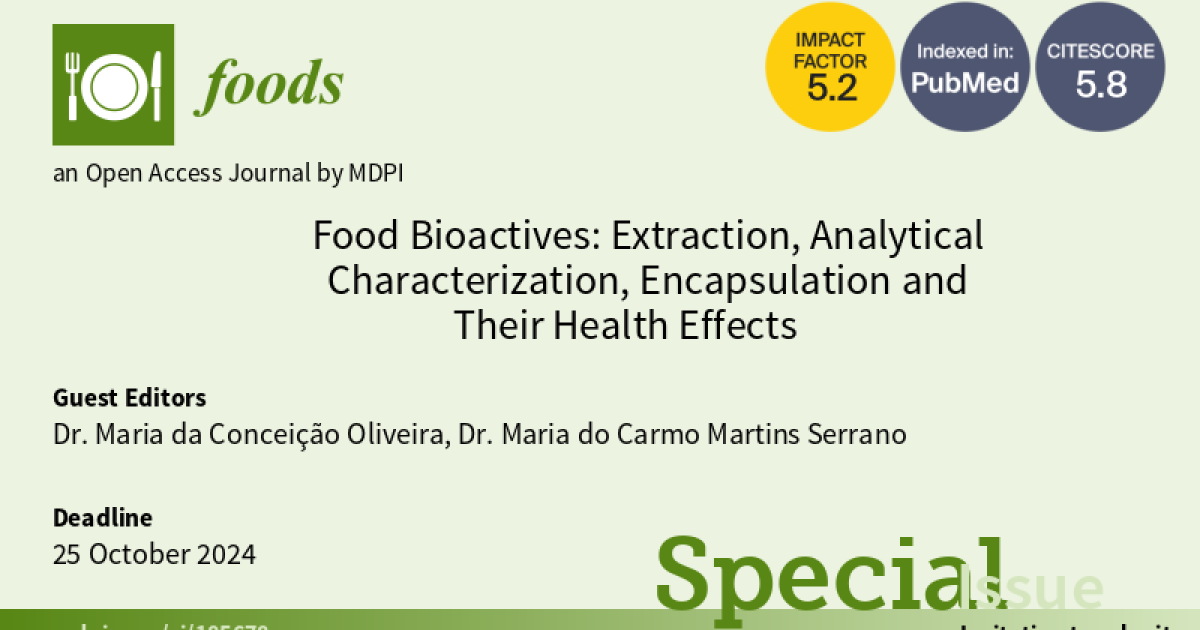Food Bioactives: Extraction, Analytical Characterization, Encapsulation and Their Health Effects
A special issue of Foods (ISSN 2304-8158). This special issue belongs to the section "Food Nutrition".
Deadline for manuscript submissions: 25 October 2024 | Viewed by 5171

Special Issue Editors
Interests: mass spectrometry; conservation and restoration; nutraceuticals; pigments; dyes
Special Issues, Collections and Topics in MDPI journals
Interests: evaluation of food quality and safety; fruits and vegetables; aromatic and medicinal plants; technology transfer; extraction of natural additives compounds; extraction of natural colorants; bio-compatible solvents; antioxidants and bactericides; encapsulation; natural additives; flavors or the natural colorants; food matrices
Special Issues, Collections and Topics in MDPI journals
Special Issue Information
Dear Colleagues,
Bioactive compounds represent a broad class of dietary metabolites derived from fruits and vegetables, such as polyphenols, carotenoids, tocopherols, and glucosinolates, among others, with cancer-preventive potential. Recently, food bioactive substances have been widely used, such as nutraceuticals and functional foods. We welcome research on the effects of food bioactives on human health to this Special Issue.
Fruit and vegetable processing wastes, such as pomace and peel parts, are potential raw materials for the extraction, isolation, and recovery of bioactive compounds. This Special Issue welcomes articles on greener and more environmentally friendly emerging extraction methods and the analytical characterisation of food bioactives.
Many bioactive molecules present in food are sensitive during processing and are easily oxidized and degraded, especially when exposed to heat, light, and pH. This Special Issue invites academics who discuss the impact of encapsulating bioactive compounds and the encapsulation technology used in the food industry to increase shelf life, functional properties, and release in a targeted and uniform manner during food processing or consumption.
Dr. Maria da Conceição Oliveira
Dr. Maria do Carmo Martins Serrano
Guest Editors
Manuscript Submission Information
Manuscripts should be submitted online at www.mdpi.com by registering and logging in to this website. Once you are registered, click here to go to the submission form. Manuscripts can be submitted until the deadline. All submissions that pass pre-check are peer-reviewed. Accepted papers will be published continuously in the journal (as soon as accepted) and will be listed together on the special issue website. Research articles, review articles as well as short communications are invited. For planned papers, a title and short abstract (about 100 words) can be sent to the Editorial Office for announcement on this website.
Submitted manuscripts should not have been published previously, nor be under consideration for publication elsewhere (except conference proceedings papers). All manuscripts are thoroughly refereed through a single-blind peer-review process. A guide for authors and other relevant information for submission of manuscripts is available on the Instructions for Authors page. Foods is an international peer-reviewed open access semimonthly journal published by MDPI.
Please visit the Instructions for Authors page before submitting a manuscript. The Article Processing Charge (APC) for publication in this open access journal is 2900 CHF (Swiss Francs). Submitted papers should be well formatted and use good English. Authors may use MDPI's English editing service prior to publication or during author revisions.
Keywords
- food bioactives
- food waste
- polyphenolics
- health benefits
- extraction
- analysis
- encapsulation
Benefits of Publishing in a Special Issue
- Ease of navigation: Grouping papers by topic helps scholars navigate broad scope journals more efficiently.
- Greater discoverability: Special Issues support the reach and impact of scientific research. Articles in Special Issues are more discoverable and cited more frequently.
- Expansion of research network: Special Issues facilitate connections among authors, fostering scientific collaborations.
- External promotion: Articles in Special Issues are often promoted through the journal's social media, increasing their visibility.
- e-Book format: Special Issues with more than 10 articles can be published as dedicated e-books, ensuring wide and rapid dissemination.
Further information on MDPI's Special Issue polices can be found here.







